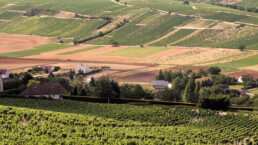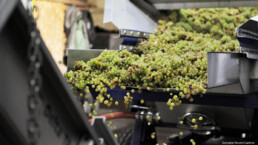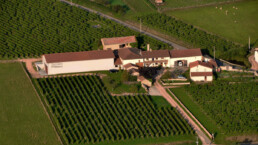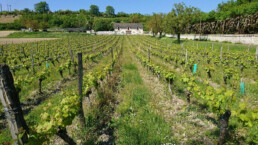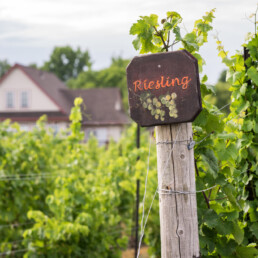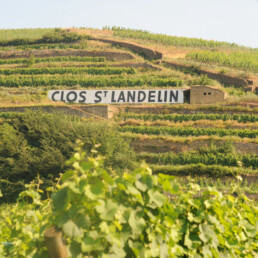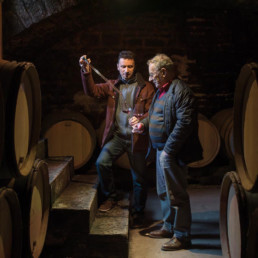If you’re longing to hop on a plane to an exciting wine destination – well, think again, it may be still some time away! The second-best option may have to be a bit of liquid armchair travelling instead. Yes, it’s time to pop open a luscious bottle of Loire wine, kick back, to sip and slip away to Le Jardin de la France – the Loire Valley.
Fortunately for you, Dhall & Nash has four awesome Loire valley producers: Alphonse Mellot in Sancerre, Domaine Vincent Carême in Vouvray, Domaine des Pothiers in the Côte Roannaise, and Domaine de Noiré in Chinon. Take your pick, or better still, order up a mixed case just to be on the ‘safe’ side and let the journey begin… ☺
We all know that France has so many famous wine regions which means that the Loire Valley sometimes gets overlooked. But let’s change that as we FOCUS ON this fairy tale-like valley following the languorous Loire River dotted with picture perfect Châteaux sitting alongside historic towns and manicured vineyards that stretch back to ancient Roman times. Truly a secret gem of France waiting for you to discover.
Fun Fact:
The Loire Valley has a long history of winemaking dating back to the Romans in the 1st century AD. In the High Middle Ages (1000 to 1300AD), the wines of the Loire Valley were the most esteemed wines in England and France, even more prized than those from Bordeaux.
The Loire is a tremendous region offering the wine lover great diversity which makes it so alluring, as it yields wines that can suit a range of different tastes. The Loire encompasses 87 appellations and 14 grape varieties. You can select from sexy sparkling to bracing whites and freshly styled reds to breezy rosé and lush dessert wines. Another hallmark of Loire Valley wine is that consistently, it is one of the best quality-to-price ratios in France – totally a wallet-friendly wine region.
Fun Fact:
The Loire Valley is the largest French area on UNESCO’S World Heritage Site List.
The Rambling Loire Valley
The Loire Valley is the longest and most bountiful rural wine region in France, hence the moniker: the Garden of France. It follows the path of the Loire River, France’s greatest waterway. Stretching over 1,000 kms in length, all the way from Nantes on the north-western Atlantic Coast to the eastern reaches and ending a little south of Paris, with more than 4,000 wineries in between!
While on the same latitude as Dijon in Burgundy, it lacks the continental climate effect of that area, instead it is at the mercy of the feisty North Atlantic. But the Loire River has a significant warming effect on the macroclimate of the region, adding the necessary extra few degrees of temperature that allows grapes to grow when the areas to the north and south of the Loire Valley have shown to be unfavourable to viticulture. Thankfully, the wines it creates are never bold and brash – they are a picture of French elegance and restraint.
Small is Beautiful in the Loire
Despite its size, the Loire Valley is a place of small holdings, artisanal winemaking and boutique producers like Vincent Carême in Vouvray or Domine de Noiré in Chinon. There’s a “less is more” mindset in many practices from the vineyard to the cellar, where less oak and manipulation let the wines shine. The new generation is more conscious about chemicals and intervention. Many are now wholeheartedly embracing organics and biodynamics. Particularly in the sprawling region around Anjou there has seen a transformation in the past 15 years into a hub for precisely the sort of wines that are popular around the world right now – ‘natural’ – made with a minimum of artifice in the cellar; free from historical baggage about what they should taste like; often produced by first-generation winemakers with no family ties to wine. This is invigorating, fun, and innovative stuff.
Fun Fact:
The Loire Valley ranks fourth in France for total area of organic wine production.
The 'Star' Grapes of the Loire
A vinous journey along the Loire Valley takes in a plethora of grapes and wine styles. Crisp Muscadets (Melon de Bourgogne) around Nantes, the gorgeously sweet ‘moëlleux’ Chenin Blancs of the Coteaux du Layon and the exquisitely complex dry Savennières Chenins from around Angers, then the more immediately appealing whites and sparkling wines of Saumur. Cabernet Franc makes the luscious reds of Anjou and the autumnal reds of Chinon and Bourgueil. Continuing upstream leads you to the famously decadent Chenins of Vouvray and on to the Touraine, Sancerre, Pouilly-Fumé and Menetou-Salon, where Sauvignon Blanc reigns supreme. Finally, the new arrival to the A.O.C scene is the Côte Roannaise and their uber-luscious savoury Gamay Saint-Romaine. Generally, however, there are 4 grape varieties that take front seat in the Loire.
Fun Fact:
The Loire wine region is the biggest producer of French AOC white wines, AND is the 2nd largest producer of French AOC Rosé wines.
The many faces of Chenin Blanc:
The Loire is synonymous with great Chenin Blanc. This is a grape that demonstrates the region at its finest, conveying the essence of terroir and winemaker methodology. From sparkling wines to bone-dry versions, from off-dry to gloriously sweet styles, Chenin Blanc transforms beautifully in the bottle. Chenin is the ultimate vinous chameleon.
Its character is very much dependent on where it is grown. Near the banks of the river, it creates full-bodied, acid-driven almost waxy dry wines that need years to fully flower. But when Chenin vines are hidden in protected little pockets away from the Loire it can create some of the world’s greatest and longest-lived dessert wines in appellations such as Vouvray, Bonnezeaux, and Quarts de Chaume. Time to taste Dhall & Nash’s Vouvrays from top biodynamic producer Vincent Carême.
Cabernet Franc – Not playing second fiddle here:
The Loire Valley might be the only wine region in the world where the Cabernet Franc variety emerges from the shadow of Cabernet Sauvignon and gets the respect it deserves! It’s a pity it has been relegated to this understudy role elsewhere because it has a lot to offer. A prime example is Dhall & Nash’s very own Domaine de Noiré Elegance from Chinon.
Overall, the reds of the Loire are very expressive, and Cabernet Franc obviously excels.
“It is subtly fragrant and gently flirtatious… Because Cabernet Sauvignon has so much more of everything – body, tannin, alcohol, colour – it is often supposed to be necessarily superior, but I have a very soft spot indeed for its more charming and more aromatic relative, Cabernet Franc.” – Jancis Robinson MW
Loire Sauvignon Blanc is a far cry from a New Zealand ‘Savvy’:
This is the spiritual homeland of Sauvignon Blanc with the famous appellations of Sancerre and Pouilly-Fumé in the Upper Loire. Sauvignon Blanc performs very differently here – due largely to the unique silex (flinty) and limestone terroirs and the cautious cultivation of the winemakers producing some of the purest, most refreshingly mineral wines in the world – as exemplified by the legendary Dhall & Nash Sancerre producer Alphonse Mellot.
Fun Fact:
Incredibly, the Sancerre AOC did not always focus on Sauvignon Blanc! Historically, local wine growers mainly cultivated Chasselas and Pinot Noir. The phylloxera epidemic changed the vineyard landscape. Growers replanted with Sauvignon Blanc and by 1931, it became the only white grape allowed in the area. Pinot Noir was named the only red variety permitted to be grown.
Sea spray freshness of Muscadet (Melon de Bourgogne):
Muscadet is made from Melon de Bourgogne to produce wines that represent one of the world’s great partnerships with seafood and fish. Its crisp, no-nonsense, brisk fruit acts like a waft of fresh air, just touched by the salt of the nearby Atlantic ocean. Muscadet is not quite as simple stylistically as it seems at first. There is fresh Muscadet, the apéritif-and-oysters type of Muscadet. And then there is a richer style, occasionally aged in wood, but certainly with spice and yellow fruits. This richer style can age, developing toasty characteristics over four to five years. Worth seeking out.
Time to Decipher Those Tricky Wine Labels and Appellations
For simplicity, the Loire can be divided into three quite different wine districts. Each district specialises in many different grape varieties and makes wines that are unlike those of the other appellations.
The Upper Loire (Closest to the Massif Central at the source of the river):
This area is the most interior part of the Loire Valley with a drier and a more continental climate than the rest of the region – but it’s still cool climate. It is less than 100 kms from famous Chablis.
Sancerre:
Grape varieties: Sauvignon Blanc for the whites, Pinot Noir for the reds and rosés.
Terroir: Clay and limestone slopes, Kimmeridgian marl, silex and flinty soils.
Pouilly-Fumé:
Grape varieties: Sauvignon Blanc, plus a small amount of Chasselas under the Pouilly-sur-Loire appellation.
Terroir: Limestone, silex, marlstone and clay.
Côte Roannaise (A recent AOP from 1994 – closer to Beaujolais than the rest of the Loire):
Grape varieties: mainly reds – made from a local variety of Gamay called Gamay St. Romain.
Terroir: Sandy, granitic soils, with particles of rock flecked with veins of quartz. It is ‘spiced’ up by the presence of volcanic soils rich in basalt.
The Middle Loire:
Famed for its Chenin Blancs, the Middle Loire also produces world-class Cabernet Franc and is home to one of the largest sparkling wine appellations in France.
Anjou, Anjou Villages, Anjou Villages-Brissac:
Grape varieties: Cabernet Franc, Cabernet Sauvignon, Gamay and Grolleau for reds. Chenin Blanc, Sauvignon Blanc, and Chardonnay for whites.
Terroir: Anjou Villages-Brissac stretches over 10 communes has schist-based soils for age-worthy reds.
Bourgueil (North of the river):
Grape variety: Cabernet Franc (up to 10% Cabernet Sauvignon is also allowed).
Terroir: 50% gravel terraces, 50% Turonian limestone (tuffeau).
St-Nicolas-de-Bourgueil (Also North of the river):
Grape variety: Cabernet Franc (up to 10% Cabernet Sauvignon is also allowed).
Terroir: 75% gravel terraces and 25% Turonian limestone (tuffeau).
Chinon (South of the river):
Grape variety: Cabernet Franc (up to 10% Cabernet Sauvignon is also allowed) for the reds, Chenin Blanc for the whites.
Terroir: Alluvial terraces, limestone slopes and clay soils
Coteaux de l’Aubance, Coteaux du Layon, Coteaux du Layon Villages, Bonnezeaux and Quarts de Chaume:
These five appellations produce sweet wines made from Chenin Blanc, using either late-harvest or botrytised grapes.
Terroir: A large diversity of soil types, including sandstone, schist, and quartz.
Montlouis-sur-Loire (Vouvray’s baby brother):
Grape variety: Chenin Blanc.
Terroir: Turonian tuffeau and clay.
Fun Fact:
The Loire Valley is the second largest sparkling wine region after Champagne. Chenin Blanc, Chardonnay and Cabernet Franc are blended together utilising the traditional method to create exceptionally detailed and fine sparkling wines that challenge many Champagnes, and at a much lower price point. Try D&N’s Vincent Carême L’Ancestrale.
Saumur (Leading Methode Traditionnelle sparkling producing area of the Loire):
Grape variety: Chenin Blanc.
Terroir: Calcareous-clay with a high clay content.
Saumur Puy-Notre:
Grape varieties: Cabernet Franc and Cabernet Sauvignon.
Terroir: The famous tuffeau made up of sedimentary rock from the Turonian era, composed of chalky, sandy marine limestone.
Saumur-Champigny (Second only to Chinon for top quality Cab Franc):
Grape variety: Cabernet Franc.
Terroir: Tuffeau, as above.
Côteaux de Saumur:
Appellation name for a tiny amount of sweet wine made from Chenin Blanc.
Saumur Mousseux & Crémant de Loire:
Sparkling wines produced primarily with Chenin Blanc, Chardonnay and Cabernet Franc.
Savennières (Arguably the greatest dry Chenin Blanc wines come from this appellation):
Grape variety: Chenin Blanc.
Terroir: Schist. Two lieux-dits have cru status: La Coulée de Serrant (7ha) and La Roche-aux-Moines (17ha).
Touraine (A complex and confusing district with 3 sub-appellations and many styles of wine):
Grape varieties: Côt (local name for Malbec) and Cabernet Franc for the reds. Sauvignon Blanc and Chenin Blanc for the whites. Pineau d’Aunis, Gamay and Pinot Gris – some used for the rosés.
Terroir: Large diversity of soil types, including flinty clays, sand, and gravel.
Vouvray (World famous, classic, and classy!):
Grape variety: Chenin Blanc (up to 5% of Orbois is also allowed).
Terroir: Calcareous clay, with flint-clay.
The Lower Loire (closest to Nantes and the Atlantic coast):
Muscadet Sèvre-et-Maine, Muscadet Coteaux de la Loire, Muscadet Côtes de Grandlieu, the Muscadet village crus, Muscadet:
Grape variety: Melon de Bourgogne.
Terroir: Sandy soils around the lake of Grandlieu, southwest of Nantes. Soils rich in foliated metamorphic rocks such as silica, schist, and gneiss. A mosaic of soil types such as amphibolite and gabbro.
Wine is close to the heart and culture of the Loire Valley. Even over the centuries when the Loire has been the embodiment of splendour, extravagance, opulence, gastronomy, and nobility, it is actually the vineyards that have continued as the lifeblood of this breath-taking region
Hopefully from your armchair travel machine you’ve indulged the impulse to dive into some intriguingly divine drops and noticed that there is not much that the Loire Valley cannot do extremely well. It is a wine region well and truly on the rise.
